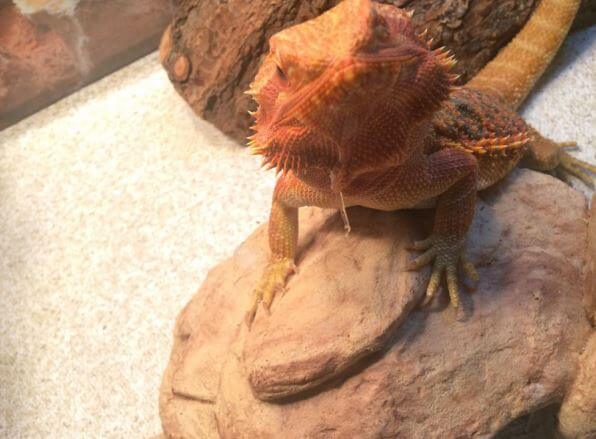Any beardie parent who has seen their bearded dragon throwing up clear liquid or any other strange stuff will likely have many questions:
- Is it bad if your bearded dragon throws up?
- What does it mean when they throw up clear slime?
- How do I give care to a sick beardie?
To answer them all, we’ll name some causes of nausea, their symptoms, and what you can do about it.
Related Posts:
- What Are Bearded Dragon Predators? Defensive Techniques
- Bearded Dragon Sleeping in Water Dish: What You Should Know
- Do Bearded Dragons Sleep Standing Up? Sleeping Habits
- Can I Put My Bearded Dragon in a Hamster Ball?
Why Is My Bearded Dragon Throwing Up?
If you go to any vet and ask the question, “Is it bad that my bearded dragon threw up?” the answer will almost certainly be some version of YES.
Unlike cows, regurgitation of any kind is not normal behavior for beardies.
However, the type of illnesses that could make your beardie throw up varies in type and severity.
Depending on the problem, vomiting in beardies can sometimes be treated at home, or at the clinic.
To figure out which is the case for your dragon, look for your beardie’s symptoms below.
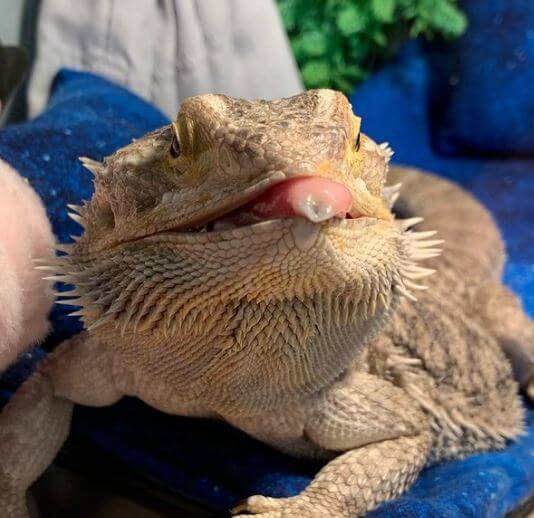
1. Digestion Problems
When someone mentions bearded dragons throwing up undigested food, the first thing that comes to mind would be digestive issues.
With beardies, there are 3 common digestive problems: bad diet, bad heating, and impaction.
Let’s break each one down.
a. Indigestion Due to a Bad Diet
We all know that a beardie’s diet should include insects.
But did you know that certain insects can give your dragon indigestion?
If your bearded dragon threw up crickets or pieces of mealworms from the meal before, then their hard shells might have been the cause.
Feeder’s insects like superworms and crickets all have hard exoskeletons, making them quite hard to digest.
The simplest way for your dragon to get rid of what it can’t digest is to vomit it out.
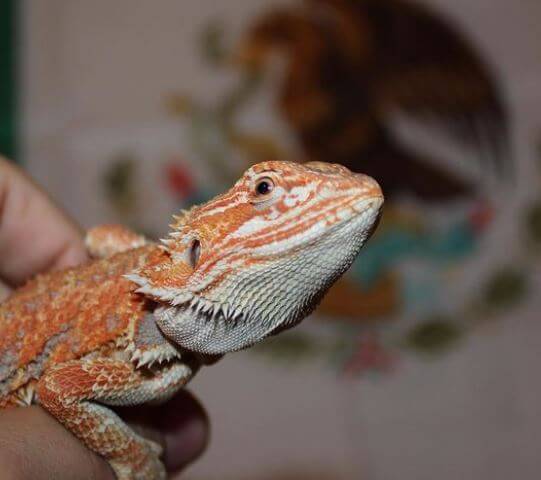
Mild indigestion can go away with time, but severe and prolonged indigestion can turn into impaction.
To avoid this, try not to feed your dragon too many tough-shelled insects like crickets, mealworms, and superworms.
Although, having variety in your beardies’ diet is not entirely a bad thing.
Hard-shelled insects can still give valuable nutrition, as long as they’re used moderately when feeding.
b. Indigestion Due to Bad Heating
Did you know that your beardie needs heat to digest foods and absorbs nutrition?
Without proper heat exposure, undigested food will stay in your beardie’s stomach and rot over time, causing them to vomit.
Because of this, owners should pay extra attention to temperatures when setting up a tank.
A good basking spot should be at around 95 to 100 degrees Fahrenheit, and the coolest spot in the tank should be at around 75 to 80 degrees Fahrenheit.
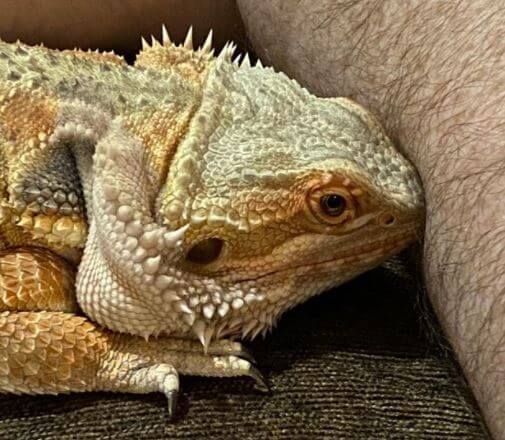
Even with a good heating system, some new owners can still make the mistake of feeding too early in the morning or too late at night.
To avoid this, allow your beardie to warm up for at least 2 hours before feeding in the morning.
Also, try to stop feeding 2 hours before lights off.
c. Impaction
A bearded dragon throwing up and not eating could be suffering from impaction.
Impaction is a digestive tract blockage caused by consuming hard-to-digest things, like loose substrates or big insects.
Loose substrates like sand or pellets, when ingested over long periods, can cause blockage.
Also, as we’ve mentioned above, certain feeders insects can cause indigestion, which over time will turn into impaction.
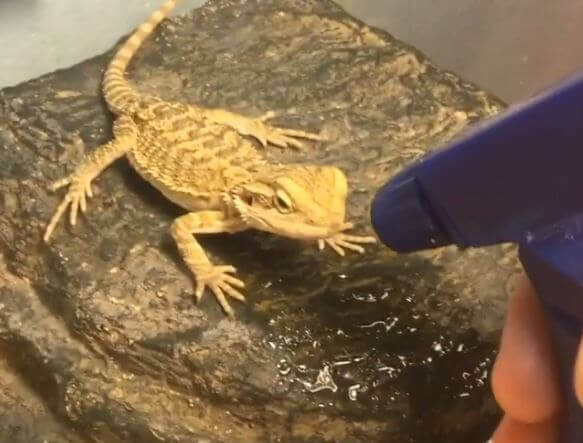
Symptoms of impaction include:
- No bowel movement (for a week or more)
- Reduced or loss of appetite
- Dragging one or both hind legs
- Vomiting
Not every impaction cases are the same.
Some go away with home remedies while others call for medical attention.
Leg immobility or dragging is a sign of severe impaction, so if you see this, take your beardie to the vet right away.
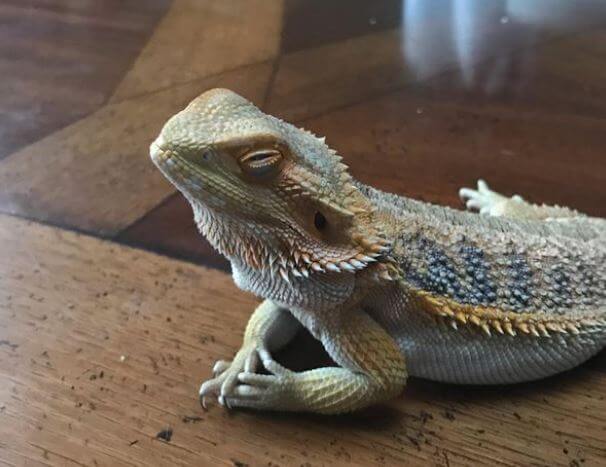
However, if the impaction doesn’t seem too bad, here’s what you can try at home:
- To help with bowel movement, try giving your beardie a warm bath. Soaking in water can help soften hard stools, making it easier for your beardie to poop.
- Also, when feeding, remember to cut the food up into smaller pieces. Food pieces no bigger than the distance between your dragon’s eyes should have no problem being digested.
- Switch to safe substrates like ceramic tiles or reptile carpets (if you haven’t already).
A general rule of thumb is: If your bearded dragon keeps throwing up even after 2 days of applying home remedies, it’s time to go to the vet.
2. Dehydration
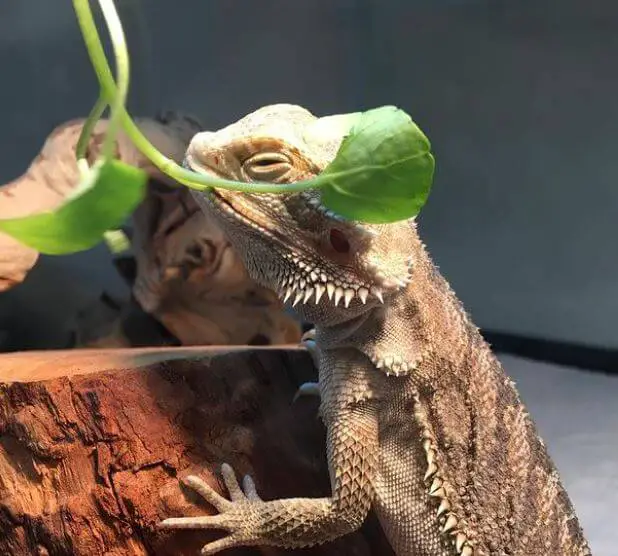
Most people would find it hard to believe that their domestic dragon is at risk of dehydration.
After all, a house beardie is much better cared for than a wild one.
However, drinking from a bowl of water is something very foreign to most beardies.
Both wild and domestic beardies would be more familiar with licking the dew of leaves, stones, or rainwater dripping off its head.
Because of this, a large number of domestic beardies won’t drink unless assisted, with many cases leading to dehydration.
Similar to humans, dehydration in beardies can cause dizziness and nausea.

If you’re not sure whether your beardie is dehydrated or not, here’s what to check for. Aside from dizziness and nausea, a dehydrated dragon will also have:
- Wrinkly skin (due to lack of elasticity, the skin can’t return to normal as fast when pinched)
- Tacky (or stringy) saliva
- Hollow or sunken eyes
- Lethargy
What to do?
The most obvious way to help a dehydrated dragon is to give it some water.
Misting and bathing will encourage your beardie to drink.
Not only that, but bathing can also help with constipation, which is something many dehydrated beardies also struggle with.
Also, try feeding them moisture-rich foods, and keep an eye on their energy level.
If your dragon seems too weak or abnormal for a few days in a row, take them to the vet.
3. Infections and Parasites
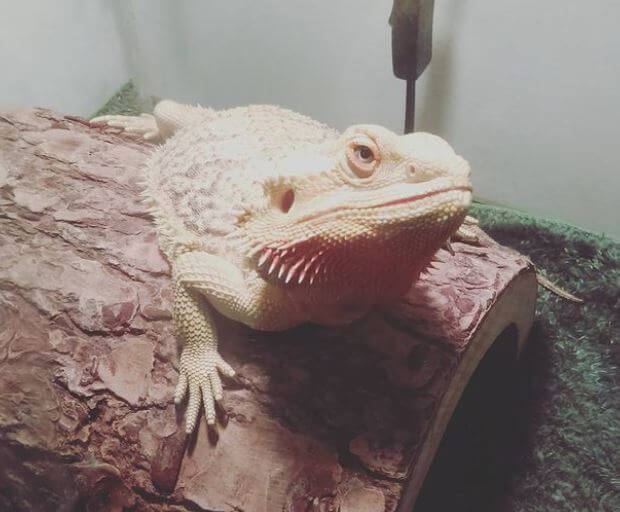
a. Parasites
There are many reasons why a bearded dragon is not eating. Earlier, we talked about how impaction can affect a beardie’s appetite.
Other than that, the second most common reason behind many beardies’ appetite loss is parasites.
Worms, coccidia, and amoebas are commonly found parasites in reptiles.
These parasites can upset your beardie’s stomach, resulting in weight loss and, in some cases, nausea.
A bearded dragon throwing up clear liquid/food while also showing other signs in the list below should be checked for parasites:
- Poor appetite
- Weight loss
- Irregular stools (bloody, mucus-laden, runny, having pieces of parasites or eggs)
- Lethargy
What to do?
A parasitic infection is best handled by a vet since treatments will often require medicine.
In most cases, your vet will need a stool sample to do a fecal examination, so try to prepare that beforehand.
After finding out the types of parasites your beardie is having, your vet will provide treatments and further instructions.
b. Respiratory Infection
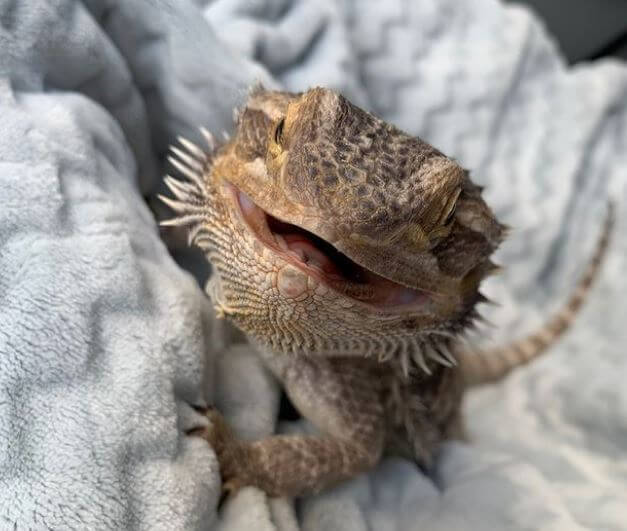
When you describe bearded dragons throwing up mucus to a vet, he or she will likely suspect a respiratory infection, among other things.
These infections are the results of bacteria build-ups in the respiratory system.
There are two main types: upper respiratory infections and lower respiratory infections.
Both will include these symptoms:
- Stringy mucus coming out of nose and mouth (sometimes, this can look like vomit)
- Black beard for more than six hours
- Gaping mouth, difficulty breathing
- Appetite and weight loss
- Snorting, sneezing, throat puffing
- Body bloating
What to do?
Only a vet will be able to diagnose and treat these types of infections.
Therefore, if your dragon has three or more of the signs listed above, you should go to the clinic as soon as possible.
What you can do at home is take preventative measures.
High moisture aids bacteria growth, so if you want to avoid bacterial-related infections, aim for good humidity control. Get a heat and humidity meter if you haven’t already, and routinely check the numbers.
A tank’s humidity is best kept around 20 to 40 percent, while the daytime temperatures should be between 75 to 85 degrees Fahrenheit.
If you’re looking for a good hygrometer/thermometer, here are our top picks:
Another cause of bacteria build-up is bad hygiene practices, like leaving leftover food inside the tank or neglecting to clean.
Therefore, it’s crucial to clean your beardie’s tank and change the water bowl daily.
Also, leftover foods should be removed right away after feeding.
All of these things take up only a few minutes a day, but they can help to prevent any unwanted illnesses.
4. Drinking Contaminated Water
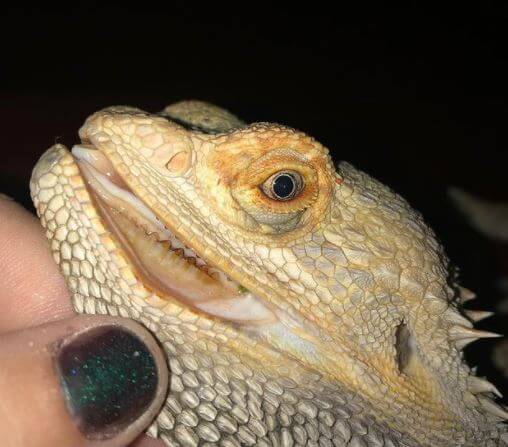
A bearded dragon throwing up clear liquid after drinking might be feeling sick from drinking contaminated water.
In captivity, there are two ways a beardie’s water can be contaminated.
a. Chemical Contamination From Tap Water
Owners usually get water for their beardies from a tap, and most beardies drink it just fine.
However, in some areas, tap water can contain high levels of fluoride or chlorine, which aren’t very good for reptiles.
If you want to play it safe, try getting a water conditioner for your tap, or try giving your dragon filtered water.
b. Your Beardie Soiled the Water Bowl
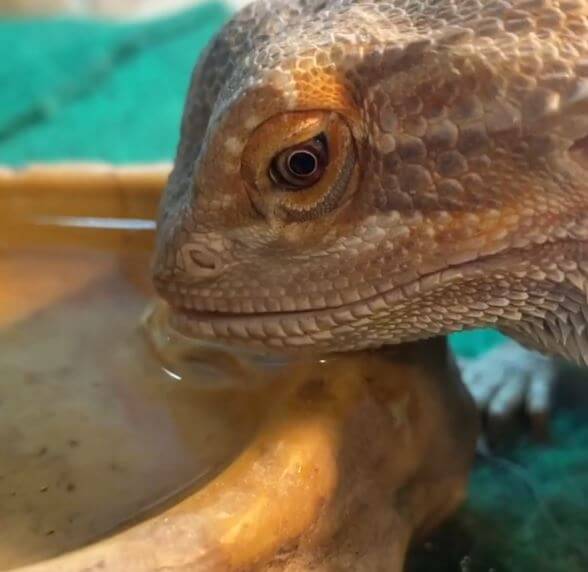
Beardies are silly creatures who will step in, splash, and even poop in their water bowls whenever they feel like it.
But we love them anyway and made it our duty to give them access to clean water.
That being said, no one has the time to keep an eye on their dragon’s water bowl all day to make sure it’s clean.
However, there are some tricks to make sure your dragon doesn’t drink the dirty water from its own doing.
If you want to keep clean a water bowl inside their tank, use one no bigger than your dragons’ heads.
This will make it hard for them to take a dip or poop in it. Also, change the water daily, since they can still get their dirty paws and other who-knows-what into the bowl.
Most beardies will go back to normal after throwing up the soiled water.
However, if your dragon is showing other signs of sickness, it might be best to go to a vet.
5. Overdrinking
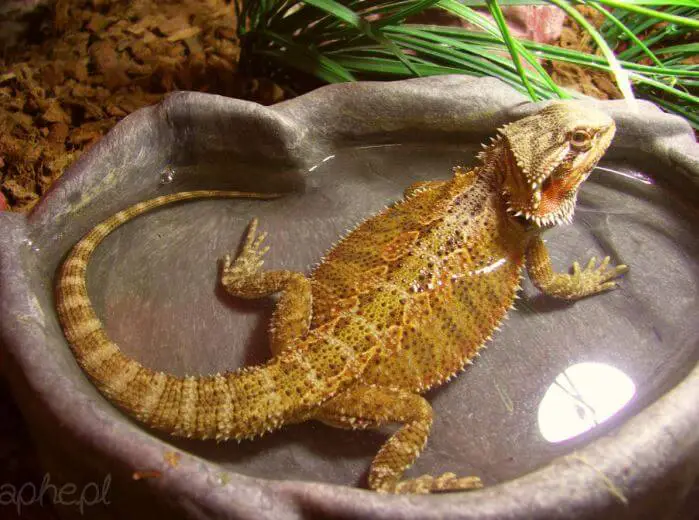
Some may be wondering, “If I’m only using filtered water, and my beardie’s showing no other sign of illness, then why is my bearded dragon throwing up water?”
If you’re thinking the same thing, then ask yourself these questions:
- Has your beardie been drinking a lot of water?
- Was he or she in a tilted position before vomiting?
If the answers are yes to both, then there’s no need to worry.
Though seeing your bearded dragon throwing up clear liquid might seem scary, drinking too much is not dangerous.
A bearded dragon vomiting clear liquid after a bath probably just overdrank.
Aside from that, climbing or hanging in a tilted downward position can also cause vomiting.
Overall, if you’re sure about water quality, a bearded dragon throwing up water but showing no other symptoms is probably fine.
Frequently Asked Questions About Bearded Dragons Health
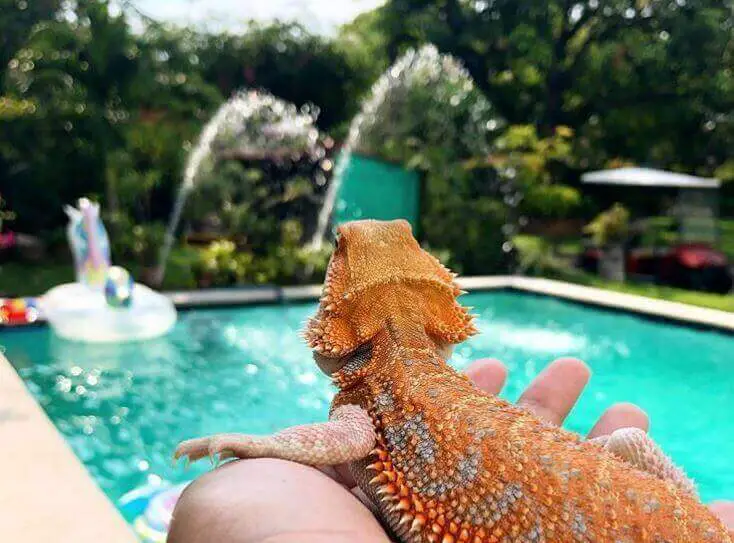
1. Can a Bearded Dragon Die From Throwing Up?
Beardies won’t die just from throwing up.
But illnesses like impaction and respiratory infections can cause life-threatening symptoms like difficulty eating or breathing.
However, this isn’t a reason to panic. If you know what is making your beardie vomit, then you can provide them with the right kind of care.
This alone can vastly reduce the odds of your beardie dying.
2. Can Bearded Dragons Throw Up on Me and Give Me Salmonella?
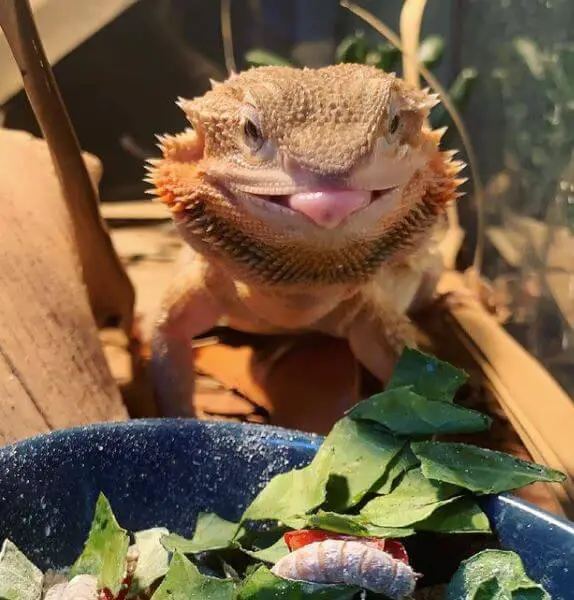
When bearded dragons throw upon you, there’s some risk of getting salmonella.
This bacteria is part of your dragon’s natural flora, meaning it doesn’t make your beardie sick.
However, salmonella causes diarrhea, fever, and abdominal cramps in humans.
Humans get the bacteria via the fecal-oral route, so as long as you don’t let the bacteria anywhere near your mouth (like touching your face after cleaning up the vomit or kissing your beardie), you should be fine.
3. How Do Bearded Dragons Get Parasites?
In most cases, house beardies get parasites from the insects they eat.
Because of this, it’s quite hard to keep your beardie parasites-free without medicinal aid.
Therefore, try to deworm your beardie twice a year following a vet’s instructions.
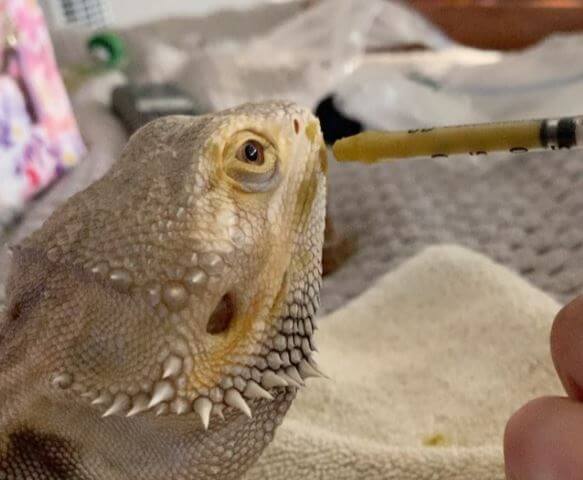
4. Do Bearded Dragons Get Sick Easily?
Among pet reptiles, beardies are relatively easy to care for.
They eat a simple diet and aren’t sick often.
However, like many other pets, beardies have specific needs in terms of food and living space.
Because of this, how easily a beardie gets sick depends on how well you take care of their needs.
Conclusion
To wrap things up, here’s what you should do for a bearded dragon throwing up clear liquid:
- Check for other symptoms. See if the symptoms match any of the illnesses listed above.
- Look at your beardie’s condition. How bad are the symptoms? If he or she seems too sick or weak, then visit your nearest vet as soon as possible (bring vomit and fecal samples if needed).
- If the condition is not too serious, you can try home remedies. But remember, if your beardie is still not doing better after 2 days of home treatments, it’s time to go to the vet.
Many of the illnesses we’ve talked about are preventable. Because of this, we advise you to give this article a careful read. Hopefully, after this, you will know not only how to identify nausea-causing illnesses, but also take preventative measures.
Key points to remember when researching bearded dragon throwing up:
Bearded dragons can occasionally regurgitate or vomit, displaying symptoms of throwing up. It’s crucial to understand the potential causes and actions to take when this happens. Here’s the information presented in bullet points for quick reference:
1. Regurgitation vs. Vomiting:
- Regurgitation: Involuntary expulsion of food or liquid shortly after ingestion, often undigested and with little warning.
- Vomiting: More forceful expulsion where the content originates from the stomach and might include partially digested or completely undigested food.
2. Common Causes:
- Overeating: Consuming too much food at once or eating too quickly can lead to regurgitation.
- Stress or Handling: Stressful situations or excessive handling can cause a dragon to throw up.
- Incorrect Temperatures: Incorrect temperatures in the basking or ambient area might disrupt digestion, leading to vomiting.
- Ingestion of Substrates: Swallowing loose substrates or bedding materials can cause blockages or irritation, resulting in vomiting.
3. Associated Symptoms:
- Lethargy: A lethargic or inactive state might accompany vomiting in bearded dragons.
- Loss of Appetite: After throwing up, a dragon might refuse to eat or show a decreased appetite.
- Abdominal Distress: Signs of discomfort, such as arching the back or refusing to move, can indicate abdominal pain.
4. Immediate Actions:
- Remove Food: If vomiting occurs shortly after a meal, remove any remaining food to prevent further ingestion.
- Monitor Closely: Keep a close eye on the dragon’s behavior, ensuring it remains hydrated and providing a comfortable environment.
- Consult a Vet: If vomiting persists or is accompanied by other concerning symptoms, seek veterinary assistance promptly.
5. Prevention:
- Proper Diet: Offer appropriate-sized food items and ensure a balanced diet to prevent overeating.
- Stress Reduction: Minimize stress factors and handle your dragon gently to reduce anxiety.
- Temperature Regulation: Maintain proper temperature gradients in the enclosure for optimal digestion.
6. Veterinary Attention:
- Professional Evaluation: If vomiting continues, or if there are signs of distress or prolonged inactivity, consult a reptile veterinarian immediately.
- Diagnostic Measures: Vets might perform tests to assess the dragon’s health, including physical exams and possibly X-rays or ultrasounds to identify underlying issues.
Bearded dragons vomiting or regurgitating can indicate various underlying health concerns. While occasional vomiting might not be alarming, persistent or severe instances warrant immediate attention. Regularly assessing the dragon’s behavior, diet, and environment can aid in preventing such episodes and maintaining their overall health. When in doubt, seeking professional veterinary advice is crucial for proper diagnosis and treatment.
Further Reading:
- Carolina Custom Cages Terrarium Review
- 8 Best Basking Rocks for Beardie: What Is the Best Choice?
- 10 Best Thermometers for Beardie: How to Choose the Best One?
- 5 Best Beardie Lighting Setups for Beardie Lovers
- 9 Best Heat Lamps for Beardie: Natural Habitat Provided


